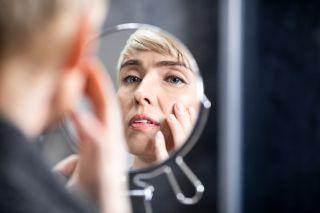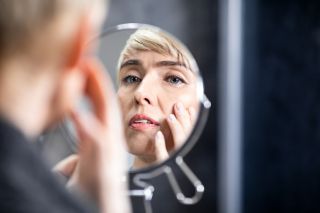How to Make Peace With Your Face. Our feelings about our appearance are so charged that we cannot trust them. Reviewed by Ekua Hagan

KEY POINTS-
- A person's image in a mirror is not the same compared to photos: The first is reversed, and the second is not.
- One's expressions are profoundly affected by their personality, which affects how others see them.
- The mental image one has of their face is not objective, but rather reflects how they feel about their looks.

It's natural to assume that our image in a mirror or photo is what others see when they look at us. We think we’re seeing reality. And yet, for many reasons, we’re likely to be wrong.
In fact, when we have a chance to view ourselves as a stranger might, we may not even recognize ourselves. This happened to Helen, whom I met shortly after she arrived in Boston from Scotland for a family celebration of her 80th birthday. When I asked how it felt to turn 80, she answered, “Unreal! When I was walking in the airport just now, I saw an old woman approaching. I practically walked into the mirrored wall before I realized it was me! I look in the mirror every day, to brush my hair or whatever, but I don’t actually see myself!”
Not knowing our true appearance is part of the human condition. For thousands of years, before the invention of photography, people only knew their faces through reflections or the rare painted portrait, both very imperfect representations. Reflections are reversed, frontal, and fleeting, while a portrait captures a single moment, filtered through the eye and (no doubt flattering) hand of the artist.
And yet even today, when we have access to a nearly limitless supply of personal photos, we’re no closer to knowing how we look to others—only more self-conscious.
Technology certainly plays a role in the disconnect between our self-image and reality. To begin with, our mirror image and our photos are not the same: The first is reversed, and the second is not. And photos distort. Turning a 3-D object into two dimensions has subtle consequences, and photos are also filtered through an artist’s eye and hand, in this case, the one behind the camera. We form our self-image through a merging of these two imperfect versions of ourselves.
The limitations of technology do not fully explain the problem
When we look at someone, we do not see a fixed, frontal image like the one we present to a mirror or camera. In life, we continuously read one another’s faces, which can change in reaction to how we each make the other feel. And our expressions are profoundly affected by our personality. When I was writing about a deceased aunt, a beautiful but anxious woman, I submitted her picture to an online site that animates photos, hoping for a deeper sense of her. It had the opposite effect: Gone was the tension in her mouth and guardedness in her eyes, which emerged in any interaction. It is this kind of personal detail we are most attuned to when we gaze at one another, not the particulars of a facial feature or two.
In fact, something even more fundamental underlies the difference between how we see ourselves and how we’re seen. Even if a photo could perfectly capture our appearance, we would not see the image as it is. The simple fact is that we cannot be objective about ourselves—least of all about our looks, a matter freighted with so much hope and fear. Some hate the way they look; others overestimate their beauty. We are doomed to see a purely subjective version of whatever our eyes take in. How could it be otherwise?
The biggest hurdle to knowing our appearance is in ourselves
Our mental image of our face reflects how we feel about our looks. It can be formed early and for good. If we were once told our ears stick out or our nose is big, we may never shed the sense of something being wrong with our face. Every time we look at ourselves, our eyes will go straight to the supposed flaw, highlighting it out of all proportion. When my mother was a child, she heard her mother say she looked like a little monkey, and despite growing up to be attractive always believed she was ugly. In contrast, my father, who had the impression he was handsome, always walked into a room anticipating the admiring eyes of every woman there, even at 90.
And then, our appearance continuously changes. Like my father and 80-year-old Helen, many of us fail to keep our self-image up to date as we age. If we look in the mirror and see our present face superimposed on earlier versions, our memory can interfere with what our eyes take in.
But young people are no better at seeing themselves as they actually are. A study published by the British Psychological Society demonstrated this when researchers asked undergraduates to choose “the most accurate photo” of themselves from 10 Facebook images and then observed them choosing the most flattering. Meanwhile, strangers were shown a short video of the students and then chose for similarity from the same set of 10 pictures. The photos selected by the students and by the strangers were then evaluated with digital face-matching technology. Who scored the highest for accuracy? The strangers, of course.
For many, to be seen is to be judged and not just by others. Recently, I spruced up for an appointment to renew my driver’s license, knowing I’d carry the resulting photo for years. And yet, the only people to ever see it will be checking my identity—policemen, pharmacists, bank clerks—and simultaneously looking straight at me and seeing exactly how I actually look. I enhanced the photo for my own satisfaction: No matter how far from it the actual me happens to look on any given day, the image on the license can remain the “real” me, for me.
Few of us are movie or social media stars selling our appearance to promote our brand. We are human beings responding to one another, seeing and being seen. Moreover, all judgment is subjective. That beauty is in the eye of the beholder is no less true for being a cliché. Is there any doubt that we each see one another in our own way?
To look out our eyes at others is to expose our face to their looking back. There’s simply no way to know what they see, but we can be sure they are not judging our face as we do. If only we could accept this truth—and stop worrying about it.
- Questions and Answers
- Opinion
- Motivational and Inspiring Story
- Technology
- True & Inspiring Quotes
- Live and Let live
- Focus
- Geopolitics
- Military-Arms/Equipment
- Art
- Causes
- Crafts
- Dance
- Drinks
- Film/Movie
- Fitness
- Food
- Jogos
- Gardening
- Health
- Início
- Literature
- Music
- Networking
- Outro
- Party
- Religion
- Shopping
- Sports
- Theater
- Wellness
- News
- Culture

